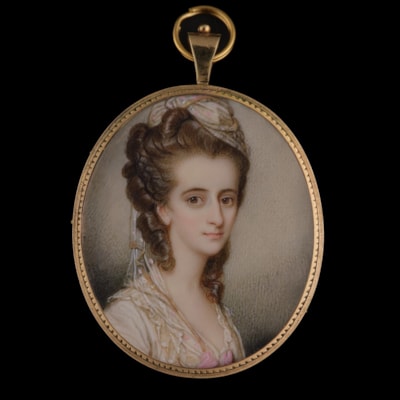JEAN-LAURENT MOSNIER
(1743/44-1808)Portrait miniature of Charlotte-Albertine-Josèphe-Maria de Buisseret, later Countess Marie-Josephe-Charlotte de Buisseret and the Viscountess de Podenas (1763-1785), wearing low-cut pink satin bodice with white chemise and light green silk bows, her upswept powdered hair entwined with pink silk ribbon, green foliage and white gauze; 1778
1778
Oval, 5.5 cm (2 ¹/₈ inches) high
Watercolour on ivory (licence number M8H834VQ)
Signed and dated ‘'Mosnier 1778'
Set into a gold-mounted dark composition bonbonnière, the gold flange of the base struck with the discharge mark of Jean-Baptiste Fouache, Paris (1775-1781)
£19,500
This miniature was painted in the same year Marie Antoinette had her first child, Marie-Thérèse, proving she was capable of providing an heir to the throne after nearly a decade of fending off doubts from the public. The current miniature was previously accompanied by a portrait of the sitter’s mother, Marie-Joséphe-Charlotte de Steenberque, the Comtesse de Buisseret de Blarenghien (1739-1800). The mother-daughter relationship presented in the original pairing would have echoed the exciting news of the arrival of a princess at Versailles. Marie Antoinette’s role as a mother would later become an important theme in royal portraits, shown, for example, in the depiction of ‘Marie Antoinette and her Children’ by Elisabeth Vigée Le Brun from 1787.
Another royal portrait by Vigée Le Brun was produced in the same year that Mosnier painted this miniature, in which she portrays Marie Antoinette in formal court dress. Similar choices in style are visible in Mosnier’s depiction of Charlotte. Her hair, in a tall, powdered updo embellished with ribbons and gauze mirrors the hairstyles introduced by Marie Antoinette while the ribbons adorning Charlotte’s dress also find parallels in the Queen’s wardrobe. This portrait shows Charlotte at 15 years old, likely eagerly following the fashions of the Queen. Charlotte was raised in Paris where Marie Antoinette’s fashion influence was most pronounced. She remained in the city until she completed her education, at which point she returned to the family home in Lille.3
Five years after this miniature was painted, Charlotte married Henri-Pierre-Jacques, Captain in the Bourbonnais regiment, Chevalier de Saint-Louis, and the future Comte de Podenas. They were wed in December 1783, holding a celebration at La Madeleine in Lille, the church where Charlotte was baptized as a baby. She spent some time at her husband’s apartment in Paris following her wedding, during which she was presented at court by her aunt, the current Comtesse de Podenas. She had a dress made especially for this event with silver satin on a white ground. Perhaps she encountered Marie Antoinette in this exquisite gown. After Paris, Charlotte traveled to Gers where she stayed at her in-law’s château de la Rocque, later returning home to Lille fatigued from her pregnancy. She gave birth to her son Jean Baptiste Charles Félix Henri on 24 November 1785, but the joy was short-lived, as Charlotte tragically died from a fever a few days later on 5 December at the age of 22.4
[1] Leo R. Schidlof, The Miniature in Europe in the 16th, 17th, 18th, and 19th Centuries (Akademische Druck- und Verlagsanstalt, 1964), 2:574, Heinz Archive, National Portrait Gallery.
[2] Pappe and Schmieglitz-Otten, Miniaturen der Zeit Marie Antoinettes, 32.
[3] P. Denis du Péage, Inventaire après décès de Madame de Podenas, Persée - Portail des revues scientifiques en SHS, 1936, 175, https://doi.org/10.3406/rnord.1936.1720.
[4] Denis du Péage, Inventaire après décès de Madame de Podenas, 177.
The sitter’s father Jean-Albert-Joseph de Buisseret, Comte de Blarenghien, Knight of the French Royal Military Order of Saint-Louis (1729-1800);
Given by him to his son, Louis-Henri-Joseph de Buisseret-Steenbecque-Thiennes, Comte de Blarenghien (1765-1845) (brother of the sitter);
Thence by family descent; Christie's, London, 21 October 1997, lot 140.
With D. S. Lavender (Antiques) Ltd., in 1997;
Christie’s, London, the collection of the late Mrs. T.S. Eliot, 20 November 2013;
Christie’s, London, the collection of the late Valerie Eliot, 2 July 2015, lot 226;
Private Collection, UK.
P.-A. Lemoisne, 'Les miniaturistes français à l'exposition de Bruxelles', Les Arts, 129, September 1912, p. 14, illustrated p. 15;
P.-A. Lemoisne, 'Le portrait-miniature en France de la Régence au règne de Louis-Philippe,
in L'Exposition de la Miniature à Bruxelles en 1912, Brussels and Paris, 1913, PP. 66-67 (L)
Mosnier nous a laissé de délicieux petits médaillons où il a représenté simplement des modèles en buste sur fond uni; parmi ceux-ci, les plus intéressants sont les portraits de la comtesse Marie-Josephe-Charlotte de Buisseret et la vicomtesse de Podenas, née Charlotte-Albertine-Maria de Buisseret, appartenant au C™ de Buisseret de Blarenghien [...J; rarement l'art de Mosnier fut mieux représenté que par ces délicates petites peintures., illustrated in colour pl. XXVII, no. 124 (the mother), monotone pl. XXVIII, no. 128;
L. R. Schidlof, The Miniature in Europe, Graz, 1964, II, pp. S74-S7S (praised as 'very good");
N. Lemoine-Bouchard, Les Peintres en miniature actifs en France 1650-1850, Paris, 2008, P. 393.

shipping notice
Worldwide shipping is included in all prices.
The Limner Company does not accept any responsibility for import duty, this is to be paid by the buyer.
Some stock items contain materials from endangered species which are governed by CITES regulations and will require a permit to export outside of Great Britain. If a certificate of export is required then this will be the responsibility of and paid for by the buyer .
you may also like



 +44(0)7983510056
+44(0)7983510056











